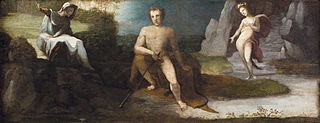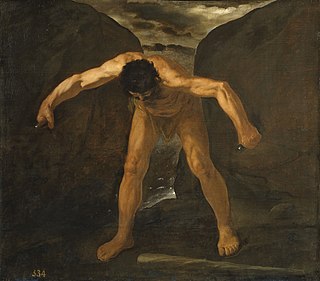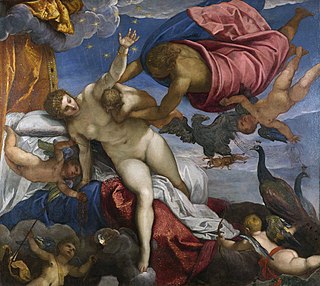 W
WThe Choice of Hercules or Hercules at the Crossroads is a c.1520-1525 oil on canvas painting by Domenico Beccafumi, now in the Museo Bardini in Florence. It is strongly influenced by Baldassarre Peruzzi's frieze at the Villa Farnesina, placing it after Beccafumi's possible trip to Rome around 1512.
 W
WThe Choice of Hercules is a painting by the Italian Baroque painter Annibale Carracci. Dating from 1596, it is housed in the Capodimonte Gallery of Naples. The subject is the Choice of Hercules.
 W
WThe Death of Hercules is a 1634 painting by Francisco de Zurbarán, now in the Museo del Prado in Madrid. It belonged to a series of paintings on the life of Hercules for the Hall of Realms at the Palacio del Buen Retiro.
 W
WHercules and Antaeus is a 1531 oil painting by the German artist Hans Baldung. It was donated in 1892 by Edward Habich to the Gemäldegalerie Alte Meister (Kassel) in Germany, where it still hangs.
 W
WHercules and Deianira is a c.1470 oil painting by Antonio del Pollaiolo, originally on panel but later transferred to canvas. It shows the rape of Deianira by the centaur Nessus, with her husband Heracles drawing a bow at the right to shoot Nessus. It is now in the Yale University Art Gallery in New Haven.
 W
WHercules and Omphale is a 1732-1734 oil on canvas painting by François Boucher, now in the Pushkin Museum in Moscow but until 1930 in the Yusupov collection in St Petersburg. It dates to the period just after Boucher completed his studies with François Lemoyne
 W
WHercules and Omphale is a circa 1602 painting by Peter Paul Rubens, now held in the Louvre Museum in Paris.
 W
WHercules and the Hydra is a c. 1475 tempera grassa on panel painting by Antonio del Pollaiolo, forming a pair with the same artist's Hercules slaying Antaeus. Both works are now in the Galleria degli Uffizi in Florence. They show the influence of the Neoplatonic Academy, harking back to classical art and interpreting Greek and Roman myth in the light of Christian philosophy.
 W
WHercules and the Hydra is a 1634 painting by Francisco de Zurbarán of Hercules fighting the Lernaean Hydra, now in the Prado Museum in Madrid. It was from a series of the Labours of Hercules for the Hall of Realms in Madrid's Palacio del Buen Retiro.
 W
WHeracles and the Lion of Nemea is a lekythos which is held at the Louvre Museum, with the representation of the first of the labours of Hercules, the slaying of the Nemean lion. It is coming from Athens, dated around 500 – 450 BCE and it was bought for Louvre Museum at 1870. It was probably created from the shop of a Tanagran artist. According to Beazley and Haspels it is attributed to the Diosphos painter.
 W
WHercules fighting Nemean lion is a 1634 work by Francisco de Zurbarán. It is conserved in the Museo del Prado.
 W
WHercules in the Garden of the Hesperides is a 1638 painting by Peter Paul Rubens. It measures 246 cm by 168.5 cm and is now in the Sabauda Gallery in Turin. It shows Hercules in the Garden of the Hesperides and forms part of a pair with the same artist's Deianira Listens to Fame.
 W
WHercules Killing the Stymphalian Birds is a 1500 tempera on canvas painting by Albrecht Dürer, now collectedin the Germanisches Nationalmuseum in Nuremberg.
 W
WHercules separating the mounts Calpe And Abyla is a work by Francisco de Zurbarán, created in 1634.
 W
WHercules's Dog Discovers Purple Dye or The Discovery of Purple by Hercules's Dog is an oil painting by Flemish artist Peter Paul Rubens painted circa 1636, towards the end of his career. It depicts the mythical discovery of Tyrian purple by Hercules and his dog, and was one of dozens of oil on panel sketches made by Rubens for the decoration of the Torre de la Parada in Spain. A completed painting based on Rubens's sketch was made by Theodoor van Thulden in 1636-8, and is now held by the Prado Museum.
 W
WThe Origin of the Milky Way is a painting by the Italian late Renaissance master Jacopo Tintoretto, in the National Gallery, London, formerly in the Orleans Collection. It is an oil painting on canvas, and dates from ca.1575–1580.
 W
WThe Origin of the Milky Way, or The Birth of the Milky Way, is a painting by the Flemish artist Peter Paul Rubens, featuring the Greco-Roman myth of the origin of the Milky Way. The painting depicts Hera (Juno), spilling her breast milk, the infant Heracles (Hercules) and Zeus (Jupiter) in the background, identifiable by his eagle and lightning bolts. Hera's face is modelled on Rubens' wife, Hélène Fourment. The carriage is pulled by Hera's favourite animals, peacocks. Due to the dark background of the night sky the figures gain a greater sense of volume.
 W
WHercules is a fresco fragment by Piero della Francesca, his only known secular work and probably originally part of a cycle of mythological figures. It dates to sometime after 1465 and is now in the Isabella Stewart Gardner Museum in Boston, which acquired it from Joseph Lindon Smith, who in turn bought it the Florentine art dealer Elia Volpi.